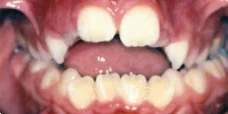Orthodontic Treatments for All Ages
Every patient has different treatment needs, Dr. Gomez will work with each patient to establish a goal and provide the most appropriate treatment catered to each individual needs.
- Aligners - Invisalign®
- Braces - Ceramic and Metal
- Dentofacial Orthopedics - Headgear, Facemask
- Surgical Orthodontics
- Temporary Anchorage Device (TAD) - Mini-implants
- Retention - Retainers
Orthodontic Treatment for Children
The American Association of Orthodontists recommends all children get a check-up with an orthodontic specialist no later than age 7. While your child's teeth may appear to be straight, there could be a problem that only an orthodontist can detect. Orthodontists can spot subtle problems with jaw growth and emerging teeth while some baby teeth are still present. A check-up may reveal that your child's bite is fine. Or, the orthodontist may identify a developing problem but recommend monitoring the child's growth and development, and then, if indicated, begin treatment at the appropriate time for the child. In other cases, the orthodontist might find a problem that can benefit from early treatment.
Problems to Watch for in Growing Children
Malocclusions ("bad bites") illustrated below may benefit from early diagnosis and full evaluation by an orthodontic specialist.
Crossbite of Front Teeth - Top teeth are behind bottom teeth
Crossbite of Back Teeth - top teeth are to the inside of bottom teeth
Crowding
Protrusion
Deep Bite
Open Bite
Underbite
Spacing
Oral Habits - Sucking on thumb, fingers
Orthodontic Treatment for Adults
Correction of orthodontic problems in adults in conjunction with regular dental care can improve overall oral health. Treatment decisions should be made in consultation with the family dentist, the orthodontist and other specialist, if necessary.
Erin discusses her experience with Orthodontic Treatment as an Adult. Courtesy of American Association of Orthodontists.
Problems to Watch for in Adults
Malocclusions illustrated below may be improved by orthodontic treatment.
Anterior Crossbite
Spacing
Crowding
Open Bite
Protrusion
Impacted/Tipped/Missing Teeth
Periodontal Problems
Tooth Wear/Bruxism
Deep Bite
Class II
Vertical Problems
Class III
Courtesy American Association of Orthodontists



























